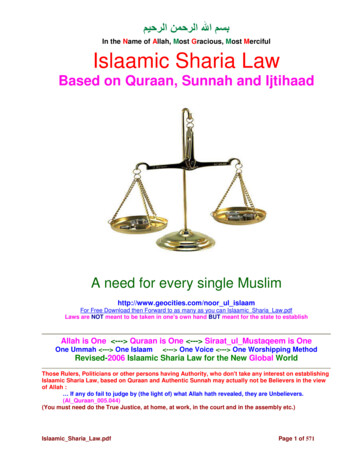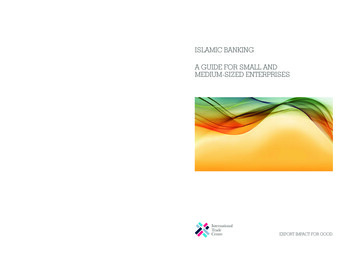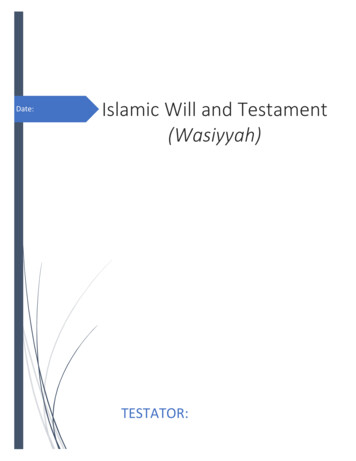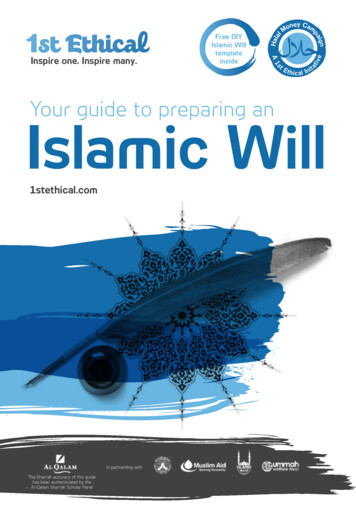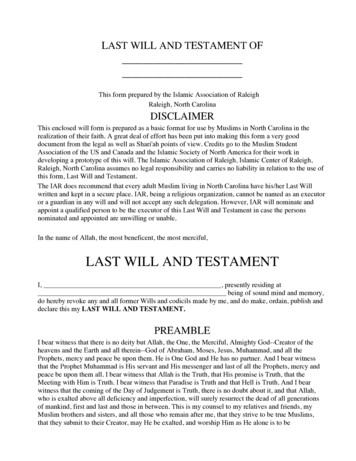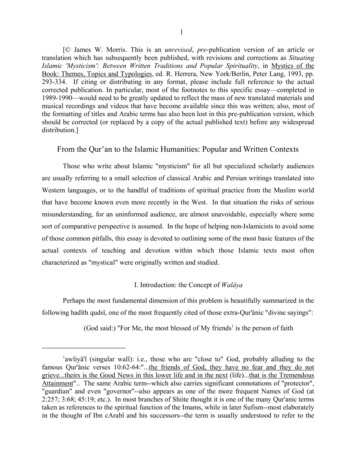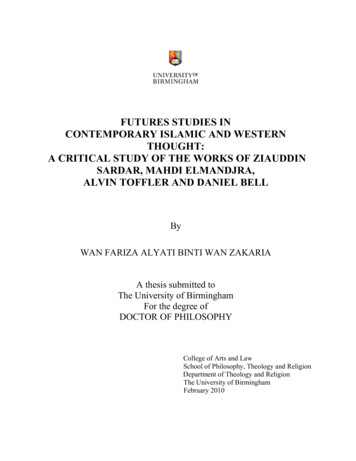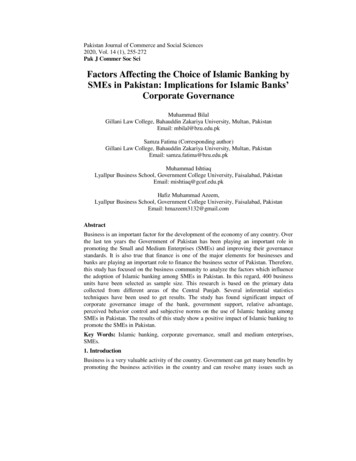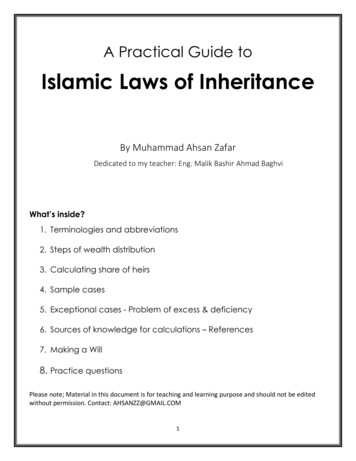
Transcription
A Practical Guide toIslamic Laws of InheritanceBy Muhammad Ahsan ZafarDedicated to my teacher: Eng. Malik Bashir Ahmad BaghviWhat’s inside?1. Terminologies and abbreviations2. Steps of wealth distribution3. Calculating share of heirs4. Sample cases5. Exceptional cases - Problem of excess & deficiency6. Sources of knowledge for calculations – References7. Making a Will8. Practice questionsPlease note; Material in this document is for teaching and learning purpose and should not be editedwithout permission. Contact: AHSANZZ@GMAIL.COM1
NotesProblem solving templateName:Date of death:Distributable Wealth:2
TERMINOLOGIESMirath - Gross Inheritance: All movable or immovable property left behind by deceased whether thedeceased earned it, inherited it or was gifted this property.Warith - Heir: A relative who may potentially inherit from the wealth of deceasedWassiya – Will: An order for allocation of certain amount of property of deceased after death basedon his/her order. This is not allocated during the person’s lifetime rather is asked to be allocatedafter death.A will of up to 1/3rd property is allowed. If a will is made in excess to this proportion then only 1/3rdwill be spent on it. A will cannot be made for a person who is already entitled to receive a share asheir (warith)Walad (awlaad) - Children (CH): This include any one of the following: son (S), daughter (D), son’sson (SS), son’s daughter (SD), son’s son’s son (SSS), son’s son’s daughter (SSD).Other types of grandchildren are not included in this definition however will be classified in Dhilihram (see below)Ikhwa – Siblings (IK): A total of 2 or more persons alive from real, paternal or maternal brothers andsisters, irrespective of their type or genderReal brother (RB) and Real sister (RS): siblings who have same parents as the deceased (haqiqi)Paternal brother (PB) and Paternal sister (PS): siblings who have same father as the deceased buthave different mothers (step-siblings with a common father) (allati)Maternal brother and Maternal sister (MT): siblings who have same mother as the deceased buthave different fathers (step-siblings with a common mother) (akhyafi)Dhil-Furoodh- 1st tier of heirs who have a prescribed proportion of share under differentcircumstances.Asbah – Residuary (Res): 2nd tier of heirs. Their proportion is not fixed, rather after applicabledistribution among Dhil-Furoodh, the rest is entitled to the closest relation among Asbah. Asbah aremale relatives related through a chain of males (exception: real sister and paternal sister)Dhil-irham (DI) – 3rd tier of heirs after Dhil-Furooz and Asbah. If there is still left over property afterdistribution to Dhil-Furooz, and there are no Asbah then Dhil-irham may be entitled to have a share.The closest in relationship will get all the remaining share.Kalala – A person who at time of death does not have any living CH (S, D, SS, SD, SSS, SSD), nor has aliving father or grandfather.3
ABBREVIATIONSTo simplify the tables of wealth distribution some relations of the heirs have been abbreviated. Theabbreviations used are listed ifeMotherFatherFather’s motherFather’s fatherMother’s motherSonDaughterSon’s sonSon’s ionSon’s son’s sonSon’s son’s daughterChildren (awlaad)Ikhwa – 2 or more siblingsReal brother (haqiqi)Real sister (haqiqi)Paternal brother (allati)Paternal sister (allati)Maternal sibling (akhyafi)Residuary (asbah)Dhil-IrhamSTEPS OF WEALTH DISTRIBUTIONThe following is the sequence of spending and distribution of Mirath after the death of a person.Funeralexpenditure(modest)Payment ofdebts/ loansPendingcommitmentsWill - upto1/3 of whatremainsDistributionamong heirsas prescribedCALCULATING SHARESStep 1: Write the name of deceased, the date and year of death, the distributable wealth amongheirs (last box in the above process).Step 2: List down all relatives who were alive at time of death of the deceased. Identify if any relativequalifies for extended Residuary [Res] Asbah category by writing “R” in front of them (male relativesthrough chain of males – see definitions).Step 3a: Go through table 1 and assign shares to each applicable heir based on the appropriateconditions.Step 3b: For the following 5 relations, if both male and female are present then ignore the femaleswhile assigning shares from table 1 and place (“) in their column. Their share will be extracted fromtable 2. These 5 relations are: 1) son [S] & daughter [D], 2) son’s son [SS] & son’s daughter [SD], 3)4
son’s son’s son [SSS] & son’s son’s daughter [SSD], 4) real brother [RB] & real sister [RS], 5) paternalbrother [PB] & paternal sister [PS]Step 4 (this step can be skipped if “share from 24” column is used in Step 3): Find the lowestcommon multiple (LCM) of the denominators of the assigned shares and multiply each numeratorwith that factor. In all cases the denominator will be 24 or less. Eg: if assigned shares are 1/6, 1/2and 1/8. Then the lowest common multiple (LCM) of the denominators 6, 2 and 8 is 24. Therespective numerators will then be 4, 12 and 3 out of total 24 shares (common denominator).Step 5: Calculate the remaining shares. Add all assigned numerators and subtract the total from thecommon denominator. In above example the assigned shares are 4, 12 and 3 out of commondenominator of 24. The sum of numerators is 4 12 3 19. The remaining shares are 24-19 5.Step 6: Move from left à right on table 2. Assign all remaining shares to the 1st applicable category.If the category is among the five relations as mentioned in step 3b then males will get twice as muchshare as females in that category. In this case, multiply the number of males in the category by 2 andadd it to number of females. Divide the assigned shares by this number and give 2 portions to malesand 1 to each female.Eg: 2 Sons [S] and 2 Daughters [D] are assigned 12 shares. Multiply number of males by 2 (2 x2 4),then add to number of females (4 2 6). 12 shares will be divided in 6 (each portion is 2 shares) andthen each males gets 2 shares each and female gets 1 share. In the end each son gets 4 shares andeach daughter gets 2 shares form total 12 shares (ratio 2:1).Step 6b: If the shares are assigned to extended Residuary [Res] (Asbah) category while using Table 2,then use Table 3 to find out closed Res in relationship who shall receive these shares.Step 7: You should now have all the shares distributed among appropriate heirs. All other relatives ofthe deceased do not get any share in mirath. Now calculate each individual’s portion by dividing theshares in each category by the number of individuals in that category. Eg: If share of wife is 6, thenfor someone with 2 wives the share of each will be 3 out of 24. At times dividing the share will leadto a number with decimal, such as dividing 13 shares in 6 individuals with lead to 2.166/person. Toavoid this you can multiply the whole column (all shares) by the number of divisions that are need.Eg: 13 x 6 78. Then each share will be 13 out of total 78. Keeping it in whole numbers make itsimple and easy to understand.Step 8: Find the share in terms of wealth ( , acres of land, %, etc.). The following formula is used:(Share of the person / Total shares) x (total wealth) Wealth share of each personTwo exceptions: Two scenarios may arise where the number of shares may be more that theassignable heirs “Problem of Excess (Masla-Radd)” or the calculated shares of heirs are greater thatavailable shares “Problem of Deficiency (Masla-Awl)”. These are discussed on page 9-10.5
Table 1: Inheritance sharesSr. #12345HeirHWDSDSSDShare1/2Share from 2412/24[CH] ConditionReference21/46/24[CH]Ö21/46/24[CH] 21/83/24[CH]Ö22/316/24[ 2 D] [S] 11/212/24[1 D] [S] 12/316/24[ 2 SD] [S. D. SS] 11/212/24[1 SD] [S. D. SS] 11/64/24[1 D]Ö [S. SS] 52/316/24[ 2 SSD] [S. D. SS. SD. SSS] 11/212/24[1 SSD] [S. D. SS. SD. SSS] 11/64/24[1 D or 1 SD]Ö [S. SS. SSS] 516F1/64/24[CH]Ö7M1/64/24[CH]Ö or [IK]Ö or [H F]Ö1/46/24[W F]Ö [1/6 condition] 61/38/24[1/6 condition] [1/4 condition] 118FF1/64/24[CH]Ö [F] 9FM1/64/24[M] [F (Hanafi & Maliki)] 10MM11RS1213PSMT1, 6If both eligible,then split 1/6.(i.e: 1/12 each)[M] 772/316/24[ 2 RS] [CH. F. FF. RB] 41/212/24[1 RS] [CH. F. FF. RB] 42/316/24[ 2 PS] [CH. F. FF. RB. RS. PB] 41/212/24[1 PS] [CH. F. FF. RB. RS. PB] 41/64/24[1 RS]Ö [CH. F. FF. RB. PB] 1/38/24[ 2 MT] [CH. F. FF] 1/64/24[1 MT] [CH. F. FF] 6Equal division2regardless of gender2
Table 2: Inheritance shares SFFF,RBRSPBPSResRaddDIStateF3,R27-(prob of(bait-F4 *A*D*A*D*E*F*84,85,94,85,9810G*B*Ref1118Guide for Table 2: Move on this table from Left to right (Sr. # 14 à 26) and assign all left over sharesfrom table 1 to the first eligible category on Table 2. The other categories will not get any share.A*: shares are divided in males and females of this category by 2:1. (eg: 2 parts for each son and 1part for each daughter)B*: From this share SD will also get a share, if she did not get it while using table 1C*: The most proximal one in this sequence will receive the share. (eg: if FF is present then F3 willnot get share, if FF is not present and F3 is present then F4 will not get share).D*: These females will only get a share here (using table 2) if they were not eligible for a share usingtable 1E*: This category of Asbah (Res) refers to additional male relatives that are related through chain ofmales. The closest one among them will receive the share and the rest will not. Use Table 3 to findout who is the closet in relation (Sr. # 27 à 144).F*: Problem of excess is explained in next section.G*: in absence of all relatives from Sr. # 1 to 24, the property can then be distributed among DhilIrham. The closest relative in this category will receive all the wealth.7
Table 3: Finding the nearest extended Asbah (Residuary for Sr # 23):Guide for use of Table 3: The alive relative with the smallest number will be considered eligible fornearest Asbah (residuary) and will inherit the residual wealth. Other people will not get any share.The chain can continue beyond F4 in the same sequence.RB: real brother, PB: paternal brother, F: fatherSAMPLE CASESAll calculation and solutions can be completed creating a single distribution table. Please use the“Steps of Wealth Distribution” to create this table. The solution are provided here for the two casesand the steps are identified by labels.Case 1: Zaid died on 21 Jan 2017 leaving behind 20,000. At time of his death the following relativeswere alive:1 Wife4 Daughters1 Maternal brother1 Son2 Son’s sons1 Maternal sisterMotherMother’s brotherCalculate the distribution of his wealth among his heirs.8Father2 Real sisters
Case 2: Sara died on June 14, 2017 leaving behind 10 acres of land. At time of her death the followingheirs were alive: 1 daughter, Mother, Mothers Mother (maternal grandmother), 2 daughter’s son, 1Son’s daughter, 2 Real brother’s sons, 1 Father’s paternal brother9
EXCPETIONAL SCENARIOS1. Problem of Return (Masla-Radd): Under certain circumstances after allocation of shares amongstall heirs with fixed shares, this is a residue left over but there are no residuaries (Asbah). This residueis then returned to those heirs who are entitled to it in proportion of their original shares. This isknown as Radd (return). This increased portion of share is not applicable to spouses (husband orwife) since they are not blood relatives (reference 10).Example (without spouse): Zaid died leaving behind 2 daughters [D], 1 maternal grandmother [MM],3 Maternal brothers [MT]. His distributable wealth is 40,000.Example (with spouse): Anas died leaving behind 1 wife [W], 1 daughter [D], mother [M], paternalgrandmother [FM] and maternal grandmother [MM]. His distributable wealth is 90,000.10
2. Problem of Deficiency (Masla-Aul): Another situation may arise where the assigned fixed sharesof heirs may exceed the denominator value. This case is rare. When this happens, the denominator isincreased to the sum of all the shares, hence all heirs have a reduction in their share proportional totheir share ratio. Having spouse heirs does not change the calculation method, in contrast to MaslaRadd.Example: Zainab died leaving behind a husband, 2 daughters, father, mother and 1 real brother. Herdistributable wealth is 50,000INELIGIBLITY FOR INHERITANCE1. HOMICIDE: The murderer of the deceased will be disqualified from his/ her inheritance, even if he/she has a prescribed share.Allah’s Messengersaid, “One who kills a man cannot inherit from him.” (Tirmidhi, Ibn Majah, Abu Dawud)2. DIFFERENCE OF FAITH: A non-Muslim does not inherit from a Muslim and a Muslim does not inheritfrom non-Muslim. If someone has a non-Muslim relative and would like to give them a share, theycan use their will of up to 1/3rd of wealth for this purpose.Prophet Muhammadsaid, “A Muslim does not inherit from a disbeliever, a disbeliever does notinherit from a Muslim.” (Sahih Bukhari & Sahih Muslim, the book of Fara’id)3. ILLIGETIMATE CHILD: A child born out of adultery (out of wed-lock) will only be regarded as the childof mother. However, falsely denying paternity is a major sin.A man and his wife had a case of Lian during the lifetime of the Prophet and the man deniedpaternity of her child. The Prophetgave his verdict for their separation (divorce) and then thechild was regarded as belonging to the wife only. (Sahih Bukhari, the book of Fara’id).Note: Seek opinion of a scholar to understand how these rules apply to each individual case.11
SOURCES OF KNOWLEDGE FOR CALCULATIONS – References used for tables1. Surah Al-Nisa 4. Verse 11Allah instructs you concerning your children: for the male, what is equal to the share of two females. But if thereare [only] daughters, two or more, for them is two thirds of one's estate. And if there is on
3 TERMINOLOGIES Mirath - Gross Inheritance: All movable or immovable property left behind by deceased whether the deceased earned it, inherited it or was gifted this property. Warith - Heir: A relative who may potentially inherit from the wealth of deceased Wassiya – Will: An order for allocation of certain amount of property of deceased after death based
